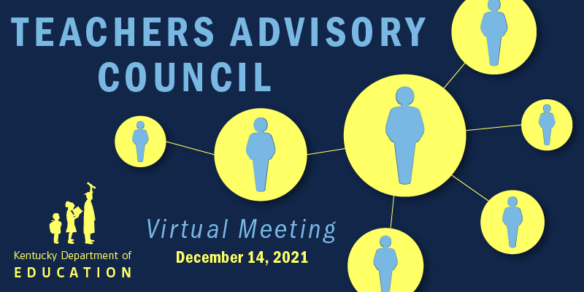
The Kentucky Department of Education’s (KDE’s) Teachers Advisory Council (TAC) heard during its Dec. 14 meeting how designing a high-quality local curriculum can support standards implementation and promote student equity.
Carrie McDaniel, professional learning coordinator in KDE’s Office of Teaching and Learning, told the council it is one piece of the larger work KDE is focused on to help schools and districts create instructional coherence. Instructional coherence is the local alignment of the standards, curriculum, instructional resources, assessment and instructional practices within and across grade levels in a school or district to help students meet the grade-level expectations.
“Creating instructional coherence is consistently identified in the research as one of the main school-level strategies that can improve student outcomes,” said McDaniel.
The first step in creating this local coherence is to design a high-quality curriculum and select high-quality instructional resources (HQIRs) that are aligned to the Kentucky Academic Standards (KAS) and promote student equity.
In July 2020, KBE passed a resolution affirming its commitment to racial equity in Kentucky’s public schools. This includes deliberate actions educators must take to ensure equitable access to learning for all students, such as local implementation of the standards and providing access to high-quality, standards-aligned local curriculum and instructional resources.
One of the main resources currently available to support schools and districts in this work is the Model Curriculum Framework. One of the key areas within this framework focuses on designing a local high-quality curriculum aligned with the KAS.
“We know that schools and districts have faced many challenges when it comes to instructional resources and the pandemic added to those challenges,” said McDaniel. “What we are trying to do is expand our support to schools and districts in evaluating and selecting resources that are aligned to KAS and that promote both student and teacher equity.”
KDE also has developed a strategic plan to equip and empower local schools and districts in providing educators with access to HQIRs and high-quality professional learning (HQPL) so they are better prepared to support all students with engaging, relevant, standards-aligned, grade-level assignments.
McDaniel said as a first step in this process, KDE “will focus our work on reading and writing, and the goal is to provide local leaders with a consumer guide that includes selection criteria and evaluation tools to support the selection of reading and writing HQIRs at the local level.”
Recognizing the importance of high-quality instructional resources and professional learning in its efforts to equitably support all students, KDE is embarking on a pilot opportunity to support districts and schools in connecting to the model curriculum framework.
The pilot will provide schools and districts with free professional learning, as well as resources and guidance in the creation of their own local curriculum aligned to the KAS for reading and writing, including on the evaluation and selection of high-quality reading and writing resources. KDE will use the feedback from the pilot to refine the HQIR work moving forward.
KDE had previously sought participation of up to 32 schools from approximately 12 districts, representing the 8 cooperative regions. Selected participants will be notified by KDE on Dec. 15.
Supporting Schools in Western Kentucky
Education Commissioner Jason E. Glass also joined the TAC meeting to provide information on what support is needed following the tornadoes on Dec. 10-11 that caused major damage in many areas of western Kentucky.
Glass said that due to the incredible support communities have received over the past few days, many schools are overwhelmed with the amount of goods being dropped off.
One of the best ways to help at this time is through monetary donations to the Team Western Kentucky Tornado Relief Fund. If you are giving physical goods, you should connect with organizations to give items that are specifically being requested.
KDE is working with schools affected by the storms to provide support wherever possible.



Leave A Comment